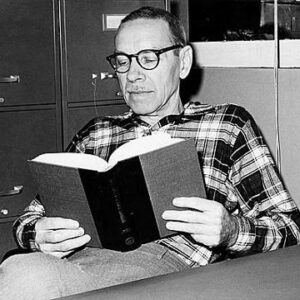Alfred Day Hershey was an American bacteriologist and geneticist who, along with Max Delbrück and Salvador Edward Luria, shared the Nobel Prize in Medicine in 1969. He found that the genetic material of life was DNA, not protein. His scientific achievements date back to his college
, when he became fascinated by bacteriology. He went on to get a doctorate in his chosen subject and was hired to work with a renowned bacteriophage researcher. He was encouraged to examine viruses, and his research rapidly yielded important breakthroughs in the knowledge of genetic inheritance and modification. His extensive research prompted several other scientists to join with him, and they were able to make some significant advancements in the genetic replication information of viruses as a result of their combined efforts. But it was his renowned ‘Hershey-Chase experiment,’ also known as the ‘blender experiment,’ that put him miles ahead of his contemporaries. His finding established DNA as the data capsule containing all of evolution’s information. It was a game-changing innovation that paved the way for a slew of future breakthroughs and achievements in the field of modern genetics.
Childhood and Adolescence of Alfred Day Hershey
Robert Day Hershey, an employee of an auto manufacturing firm, and his wife, Alma Wilbur Hershey, had him on December 4, 1908 in Owosso, Michigan, United States.
He acquired his early schooling at Owasso High School and attended at Michigan State College after graduating from high school in 1925.
He took a significant interest in bacteriology while an undergraduate student at the college. In 1930, he earned his Bachelor of Science in Chemistry.
In 1934, he received his doctorate in bacteriology from the same university. His doctoral dissertation focused on the chemistry of the Brucella bacteria, which causes Brucellosis or undulant fever, and his thesis mostly described bacterial component separation.
A Career of Alfred Day Hershey
He was hired as a lecturer in the Department of Bacteriology and Immunology at Washington University School of Medicine in St. Louis after receiving his doctorate. He had the opportunity to collaborate with Jacques Jacob Bronfenbrenner, a pioneer in bacteriophage research.
Bronfenbrenner pushed his faculty members to examine bacteriophages as he pursued his studies on their physical and lysogenic features. He and Bronfenbrenner published publications on the growth of bacterial cultures from 1936 to 1939.
Between 1934 and 1950, he worked at Washington University for 16 years, teaching and researching. In 1938, he was appointed to assistant professor, and in 1942, he was promoted to associate professor.
He conducted his own investigations on the immunologic reactivity of phages and other parameters that controlled phage infectivity in the early 1940s. In 1943, he received an invitation from Max Delbruck, a biophysicist who was also working on phage research at the time. Delbruck wanted to meet with him and a biologist, Salvador Edward Luria, to discuss the results of his phage studies.
Hershey accepted the invitation and traveled to Nashville, where the three scientists founded a phage group, a group of scientists that fostered research on specific bacteriophage strains and gathered every year at Cold Spring Harbor to discuss their findings and progress.
He and Luria independently found that phage viruses and the bacteria they infect can experience spontaneous changes in 1945. Later, he and Dr. Delbruck discovered that when two strains of bacteriophage infect the same bacterial cell, they can swap genetic material, resulting in a hybrid of the two. Hershey coined the term “genetic recombination” to describe this process.
His research on bacteriophages has shifted from immunology to genetics, biochemistry, and molecular biology.
In 1950, he relocated to Cold Spring Harbor, New York, with his assistant, Martha Chase, to work as a staff scientist in the Department of Genetics at the Carnegie Institution of Washington.
The ‘Hershey-Chase experiment,’ also known as the ‘blender experiment,’ was carried out by him and Chase in 1952.
In 1962, he became the Director of the Carnegie Institution’s Cold Springs Harbor’s Genetics Research Unit, where he continued his work on phage recombination and genetics.
He resigned from active research in 1974, but he continued to visit his research lab on a regular basis after that.
Major Projects of Alfred Day Hershey
He is most known for the groundbreaking ‘blender experiment,’ which he did with his colleague Martha Chase in 1952, concluding that deoxyribonucleic acid (DNA) is the genetic substance of life, not its accompanying protein. It was the discovery that DNA is the blueprint for all living things on the earth that created the foundation for modern molecular genetics.
Achievements & Awards
In 1958, he was elected to the ‘National Academy of Sciences,’ and in 1959, he was elected to the ‘American Academy of Arts and Sciences.’
He was awarded the ‘Albert Lasker Basic Medical Research Award’ in 1958 and the ‘Kimber Genetics Award’ in 1965.
In 1969, he was awarded the Nobel Prize in Medicine, which he shared with Salvador Luria and Max Delbrck. They were awarded the Nobel Prize for their findings of virus replication and genetic structure.
Personal History and Legacy
He married Harriet Davidson, better known as Jill, in 1945, and they had a son named Peter.
On May 22, 1997, in Syosset, New York, he died of heart failure. He was laid to rest in Oyster Bay, New York’s St. John’s Church Cemetery.
Estimated Net Worth
Alfred is one of the wealthiest physiologists and one of the most well-known. Alfred Hershey’s net worth is estimated to be $1.5 million, according to Wikipedia, Forbes, and Business Insider.


